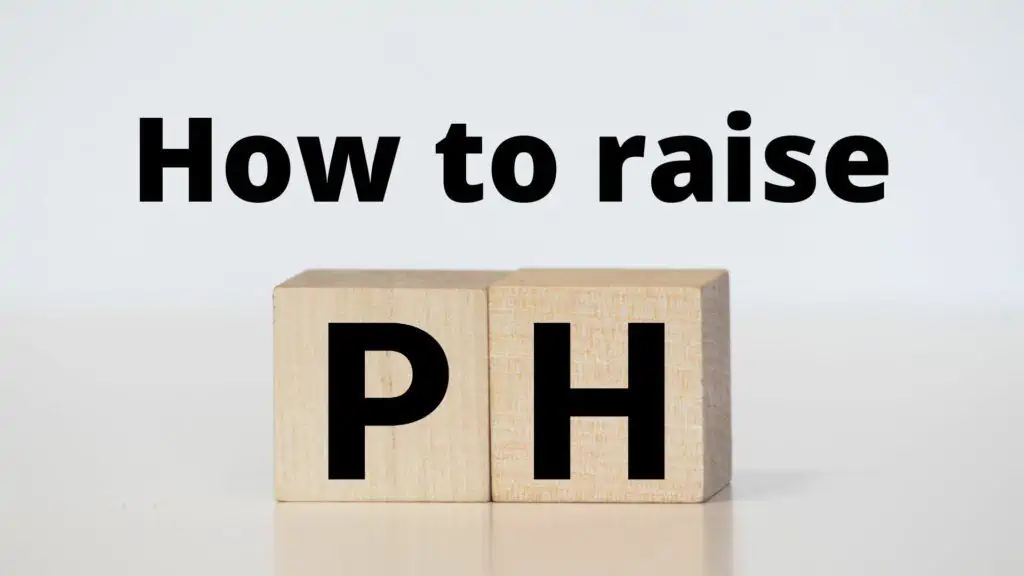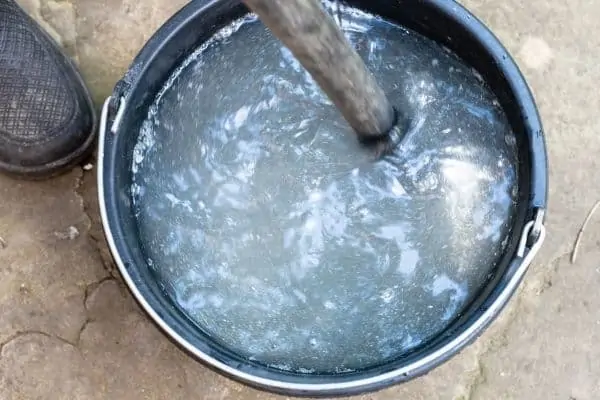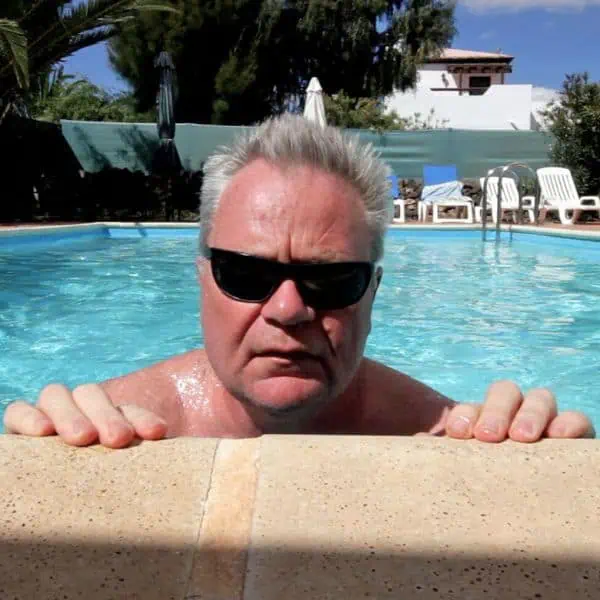Most people who have a pool in their backyard probably know that the pH levels in swimming pools need to be maintained for safety reasons. But if the pH drops, how do you raise it?
To raise the pH level in a pool, you can use either baking soda (sodium bicarbonate) or soda ash (sodium carbonate). You should add these in stages until the pH is between 7.2 and 7.6. Adding too much, too quickly, can adversely affect your pool.
Even when pool maintenance is carried out properly, the pH levels can still drop to dangerous levels for the pool equipment and swimmers. It is, therefore, important to know how to quickly and safely increase the pH in your swimming pool water.

How to increase pH in pool – step by step
It is not a complicated procedure to raise pH levels. Just remember not to try to raise it too much in one go; otherwise, that could lead to other problems.
1. Test the water
A pool’s pH level is a measurement of acidity, and it is measured on a pH scale from 0 to 14, with lower numbers being more acidic and higher numbers being less acidic or alkaline (base). Test the water using test strips or liquid to determine how far off your pool water is from the ideal reading of 7.2 and 7.6.
You can also take a water sample to your local pool store to be analyzed; many will do this free of charge. Just be mindful that their main motivation for this service is selling you chemicals.
2. Work out the amount of chemicals you need
To work out how much baking soda or soda ash to add, you must know the approximate volume of water in your pool. You can read this post to find out how to calculate the volume of water.
If your pool’s total alkalinity is also low, you should probably use baking soda. However, if the pool’s total alkalinity level is not too far from the ideal level of between 80-120 mg/liter (20-30 mg/gallon), then soda ash may be the best chemical to add. (See below for more help on which to use).
For every 10,000 gallons of pool water, you will need to add around 12 oz of soda ash or 3-4 pounds of baking soda to increase pH by 0.4
I suggest that you always add the chemicals in stages – add some, wait a few hours and retest. Add more if necessary.
Important: Exact doses vary with total alkalinity, temperature, and other factors. This calculator provides a rough estimate. Always add chemicals gradually and retest.
Pool pH Level Calculator
Use this calculator to estimate how much chemical to add to raise or lower the pH of your swimming pool.
3. Mix the chemicals with water

Whether you are using baking soda or soda ash, always fill a five-gallon bucket with water and then add them to it, mixing thoroughly before adding them to the pool. Don’t try and add too much at a time. Just enough to fully dissolve it, then do it again if you need to.
Never put the chemicals in the bucket first; put water in afterward. Always water first.
4. Add mixed chemicals to the pool
Walk around the pool’s edge, pouring the chemicals from the bucket as you go to distribute them as thoroughly as possible.
5. Retest the water
Make sure you run the pool pump and wait a few hours for the chemicals to mix and do their job thoroughly. Then, retest the water, and if the pH levels are still low, repeat the procedure.
What is the difference between baking soda and soda ash?
There is a big difference between the two.
- Baking soda is sodium bicarbonate (NaHCO3), with a pH of 8.4.
- Soda ash is sodium carbonate (Na2CO3) with a pH of 11.6, so it is far more alkaline.
It takes more baking soda to raise a pool’s pH levels by the same amount as soda ash, which is more alkaline. Because of this, it is easy to add too much soda ash and increase the pH levels more than is desirable.
If you do this, you will have to add something such as muriatic acid to bring the levels back down again. In other words, it is easy to end up chasing your tail, turning your pool into a chemical bath.
Baking soda is likely to increase the total alkalinity in addition to raising the pH, whereas soda ash will have less of an effect on total alkalinity.
When to use each type
When raising the pH in a pool, you should consider not only the pH but the total alkalinity level:
- If your total alkalinity is close to being correct, but your pH is low, then add soda ash to raise the pH level without raising the total alkalinity too much.
- If the total alkalinity and the pH level are low, adding baking soda would be best to raise the pH and total alkalinity.
For more information, read my post What does baking soda do to a pool?
How to raise pH in pool naturally
Aeration
A natural technique to raise pH in your pool involves aeration. By utilizing water features such as fountains, waterfalls, or jets, you can increase the oxygen exchange within the pool water, which in turn helps raise the pH level naturally.
Increased aeration facilitates the expulsion of excessive carbon dioxide from the water, consequently increasing the pool’s pH balance.
Borax
Utilizing borax as a pH-raising agent can be an effective and natural method.
Borax is easily available and can be added directly to your pool water. Referencing the product instructions, begin by determining the required amount of borax for your pool’s size. After dissolving the measured amount of borax in water, gradually pour it into your pool while the circulation system is running.
This natural solution helps raise the pH and maintain the alkaline balance in your pool water.
What causes low pH in the pool?
If the pH is too low, it could be due to a variety of factors, including the natural decomposition of organic matter and high levels of metals in the water. In pools without chlorination systems, lowering the pH will also cause higher chlorine demand, leading to increased chemical costs for maintenance.
Lower pool pH levels can be caused by either high chlorine levels or low alkalinity.
High chlorine levels
A high chlorine level in the pool means that there is a higher concentration of hypochlorous acid than would be expected. Hypochlorous acid kills bacteria and other germs but also causes low pH levels.
The cause for this could be too much chlorine being added to the water or insufficient time before adding more chlorine.
Low alkalinity
Low alkalinity in the pool is caused by an imbalance between pH and calcium hardness. When there isn’t enough calcium present, many of the bicarbonates will convert to carbon dioxide instead.
What happens if pH is too low in the pool?
The pool’s overall health could suffer if proper care isn’t taken because bacterial growth rates increase with lowered pH. It may not take long before you have a green or black slimy surface and an unpleasant odor from your pool.
It also can give a swimmer itchy skin and irritated eyes.
The pool pH should be in the range of 7.2 to 7.6, which is generally a similar pH to that of human tears. If the pH is lower than this (or higher), then that is a major factor in making your eyes sore after opening them underwater. When that happens, people assume it is because of too much chlorine, but that isn’t usually correct. It is more likely incorrect pH.
Does low pH affect chlorine?
Low pH has a huge impact on chlorine. Chlorine needs a pH of at least 7 to work properly, so if the pH in a pool is below this level, it will have severely reduced effectiveness.
This means that even though you may be adding enough chlorine for effective cleaning and disinfection purposes, low pH levels can dramatically increase bacteria counts, which could lead to skin irritation or eye damage.
To avoid these drawbacks, keep your water at an acceptable pH range by monitoring regularly with a test kit and adjusting accordingly when necessary.
Does low pH in the pool cause algae?
The answer to this is “yes and no.” Low pH levels on their own do not cause algae. However, the high levels of chlorine in combination with low pool pH can promote algal growth. Basically, low pH in your pool will not directly affect the algae in your pool, but it can help the algae grow faster.
Algae in a pool can be caused by several different factors. Algae needs a balance between chlorine and pH-determining chemicals to thrive in water – when any of these are out of the desired range, algae will form.
This happened to me this spring when I opened my pool (not that I actually close it, as the climate is very mild here). I had neglected the pool for a few weeks as I had to go overseas and when I checked the pool chemistry, the pH was very low. So I added a quantity of pH Plus (alkaline). Within a few hours, the pool went from clear to green, as you can see in the photo below.
I soon rectified this by shocking the pool a few times and then vacuuming on waste to remove the dead algae.

How long does it take to raise pH in the pool?
The goal of raising the pH in a swimming pool is to restore it to acceptable levels for swimming, and this time, it will depend on how low the pH has been allowed to drop before being corrected.
Raising pH levels in the average-sized pool will take anywhere from 6 hours to 10 hours. But it’s important to remember that the more acidic the pool water is, the longer it will take for the pool pH balance to stabilize.
If the pH in swimming pool water has been allowed to drop below a level of around six, meaning acidic water, it could take up to 24 hours before reaching an acceptable level.
The time needed for a pool’s pH balance will differ depending on how low it’s dropped and what type of chemicals are used.
So if you want to know how to raise ph in pool quickly, you will just need some patience.
Will shocking a pool raise the pH in the pool?
Chlorine pool shock isn’t going to raise pH levels. The high levels of chlorine actually cause a lower pH level in pool water and can make it even worse.
To increase the pH in swimming pools, you need to add either sodium carbonate or sodium bicarbonate, which is available at most home improvement stores. Pool stores will sell “pH increasers,” but these are normally just sodium bicarbonate at higher prices.
These chemicals have a double effect: they work as chemical stabilizers (keeping pool water clear) while lowering the acidity index (raising the pH levels).
Related articles
If you have the opposite problem and need to lower pH in pool water, then you will find help here – What happens if your pH is too high
FAQs
How can I raise the pH in my pool fast?
If you use soda ash, the pH levels will increase faster than adding baking soda as it is a stronger alkaline.
Will low pH make my pool green?
Although it will not make your pool green on its own, it will make chlorine less effective at killing algae or preventing its growth, so, indirectly, yes, it can.
Should I raise pH or alkalinity first?
The total alkalinity will increase as you raise the pH. Using baking soda will raise the total alkalinity more when increasing the pH than using soda ash.






Leave a Reply